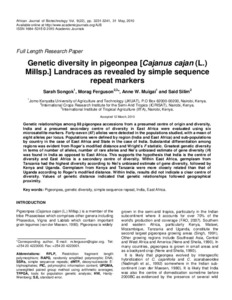| dc.contributor.author | Songok, S. |
| dc.contributor.author | Ferguson, M. |
| dc.contributor.author | Muigai, Anne W.T. |
| dc.contributor.author | Silim, S. |
| dc.date.accessioned | 2019-12-04T11:10:51Z |
| dc.date.available | 2019-12-04T11:10:51Z |
| dc.date.issued | 2010 |
| dc.identifier.citation | Songok, S., Ferguson, M., Muigai, A.W. & Silim, S. (2010). Genetic diversity in pigeonpea [Cajanus cajan (L.) Millsp.] landraces as revealed by simple sequence repeat markers. African Journal of Biotechnology, 9(22), 3231-3241. |
| dc.identifier.issn | 1684-5315 |
| dc.identifier.uri | https://hdl.handle.net/20.500.12478/2283 |
| dc.description | Open Access Journal |
| dc.description.abstract | Genetic relationships among 88 pigeonpea accessions from a presumed centre of origin and diversity, India and a presumed secondary centre of diversity in East Africa were evaluated using six microsatellite markers. Forty-seven (47) alleles were detected in the populations studied, with a mean of eight alleles per locus. Populations were defined by region (India and East Africa) and sub-populations by country in the case of East Africa and State in the case of India. Substantial differentiation among regions was evident from Roger’s modified distance and Wright’s F statistic. Greatest genetic diversity in terms of number of alleles, number of rare alleles and Nei’s unbiased estimate of gene diversity (H) was found in India as opposed to East Africa. This supports the hypothesis that India is the centre of diversity and East Africa is a secondary centre of diversity. Within East Africa, germplasm from Tanzania had the highest diversity according to Nei’s unbiased estimate of gene diversity, followed by Kenya and Uganda. Germplasm from Kenya and Tanzania were more closely related than that of Uganda according to Roger’s modified distance. Within India, results did not indicate a clear centre of diversity. Values of genetic distance indicated that genetic relationships followed geographical
proximity. |
| dc.format.extent | 3231-3241 |
| dc.language.iso | en |
| dc.subject | Cajanus Cajan |
| dc.subject | Genetic Variation |
| dc.subject | Simple Sequence Repeat |
| dc.subject | Pigeonpea |
| dc.title | Genetic diversity in pigeonpea [Cajanus cajan (L.) Millsp.] Landraces as revealed by simple sequence repeat markers |
| dc.type | Journal Article |
| dc.description.version | Peer Review |
| cg.contributor.affiliation | Jomo Kenyatta University of Agriculture and Technology |
| cg.contributor.affiliation | International Crops Research Institute for the Semi-Arid Tropics |
| cg.contributor.affiliation | International Institute of Tropical Agriculture |
| cg.coverage.region | Africa |
| cg.coverage.region | Asia |
| cg.coverage.region | East Africa |
| cg.coverage.region | Southern Africa |
| cg.coverage.country | India |
| cg.coverage.country | Kenya |
| cg.coverage.country | Malawi |
| cg.coverage.country | Mozambique |
| cg.coverage.country | Tanzania |
| cg.coverage.country | Uganda |
| cg.creator.identifier | Morag Ferguson: 0000-0002-7763-5173 |
| cg.identifier.url | https://www.ajol.info/index.php/ajb/article/view/80648 |
| cg.isijournal | ISI Journal |
| cg.authorship.types | CGIAR and developing country institute |
| cg.iitasubject | Genetic Improvement |
| cg.iitasubject | Grain Legumes |
| cg.iitasubject | Plant Breeding |
| cg.iitasubject | Plant Genetic Resources |
| cg.journal | African Journal of Biotechnology |
| cg.howpublished | Formally Published |
| cg.accessibilitystatus | Open Access |
| local.dspaceid | 91891 |
| cg.targetaudience | Scientists |

